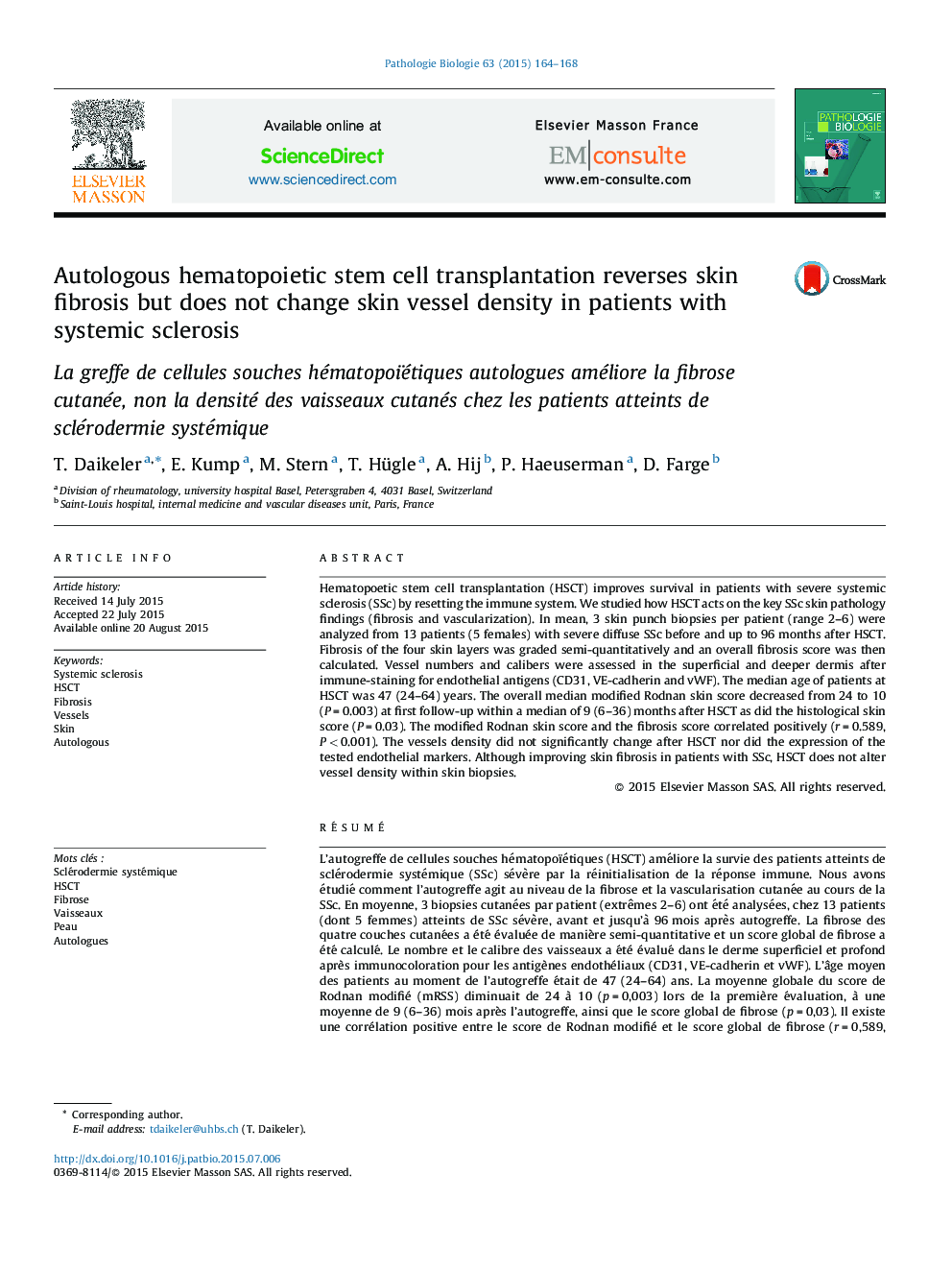| کد مقاله | کد نشریه | سال انتشار | مقاله انگلیسی | نسخه تمام متن |
|---|---|---|---|---|
| 4135857 | 1606678 | 2015 | 5 صفحه PDF | دانلود رایگان |
Hematopoetic stem cell transplantation (HSCT) improves survival in patients with severe systemic sclerosis (SSc) by resetting the immune system. We studied how HSCT acts on the key SSc skin pathology findings (fibrosis and vascularization). In mean, 3 skin punch biopsies per patient (range 2–6) were analyzed from 13 patients (5 females) with severe diffuse SSc before and up to 96 months after HSCT. Fibrosis of the four skin layers was graded semi-quantitatively and an overall fibrosis score was then calculated. Vessel numbers and calibers were assessed in the superficial and deeper dermis after immune-staining for endothelial antigens (CD31, VE-cadherin and vWF). The median age of patients at HSCT was 47 (24–64) years. The overall median modified Rodnan skin score decreased from 24 to 10 (P = 0.003) at first follow-up within a median of 9 (6–36) months after HSCT as did the histological skin score (P = 0.03). The modified Rodnan skin score and the fibrosis score correlated positively (r = 0.589, P < 0.001). The vessels density did not significantly change after HSCT nor did the expression of the tested endothelial markers. Although improving skin fibrosis in patients with SSc, HSCT does not alter vessel density within skin biopsies.
RésuméL’autogreffe de cellules souches hématopoïétiques (HSCT) améliore la survie des patients atteints de sclérodermie systémique (SSc) sévère par la réinitialisation de la réponse immune. Nous avons étudié comment l’autogreffe agit au niveau de la fibrose et la vascularisation cutanée au cours de la SSc. En moyenne, 3 biopsies cutanées par patient (extrêmes 2–6) ont été analysées, chez 13 patients (dont 5 femmes) atteints de SSc sévère, avant et jusqu’à 96 mois après autogreffe. La fibrose des quatre couches cutanées a été évaluée de manière semi-quantitative et un score global de fibrose a été calculé. Le nombre et le calibre des vaisseaux a été évalué dans le derme superficiel et profond après immunocoloration pour les antigènes endothéliaux (CD31, VE-cadherin et vWF). L’âge moyen des patients au moment de l’autogreffe était de 47 (24–64) ans. La moyenne globale du score de Rodnan modifié (mRSS) diminuait de 24 à 10 (p = 0,003) lors de la première évaluation, à une moyenne de 9 (6–36) mois après l’autogreffe, ainsi que le score global de fibrose (p = 0,03). Il existe une corrélation positive entre le score de Rodnan modifié et le score global de fibrose (r = 0,589, p < 0,001). La densité vasculaire n’a pas changé de façon significative après l’autogreffe, ni l’expression des marqueurs endothéliaux testés. Malgré l’amélioration de la fibrose cutanée chez les patients porteurs de SSc, l’HSCT ne modifie pas la densité vasculaire au niveau des biopsies cutanées.
Journal: Pathologie Biologie - Volume 63, Issues 4–5, September 2015, Pages 164–168
